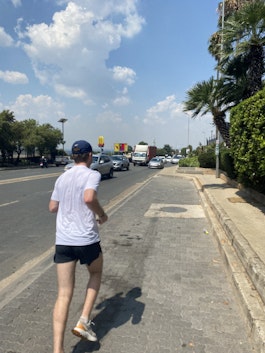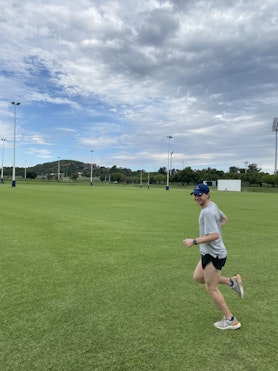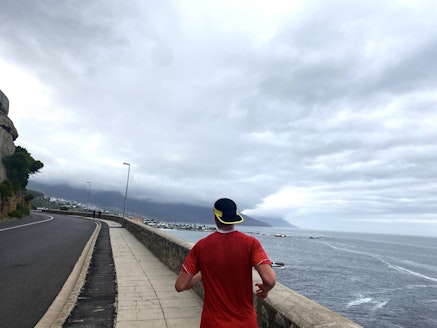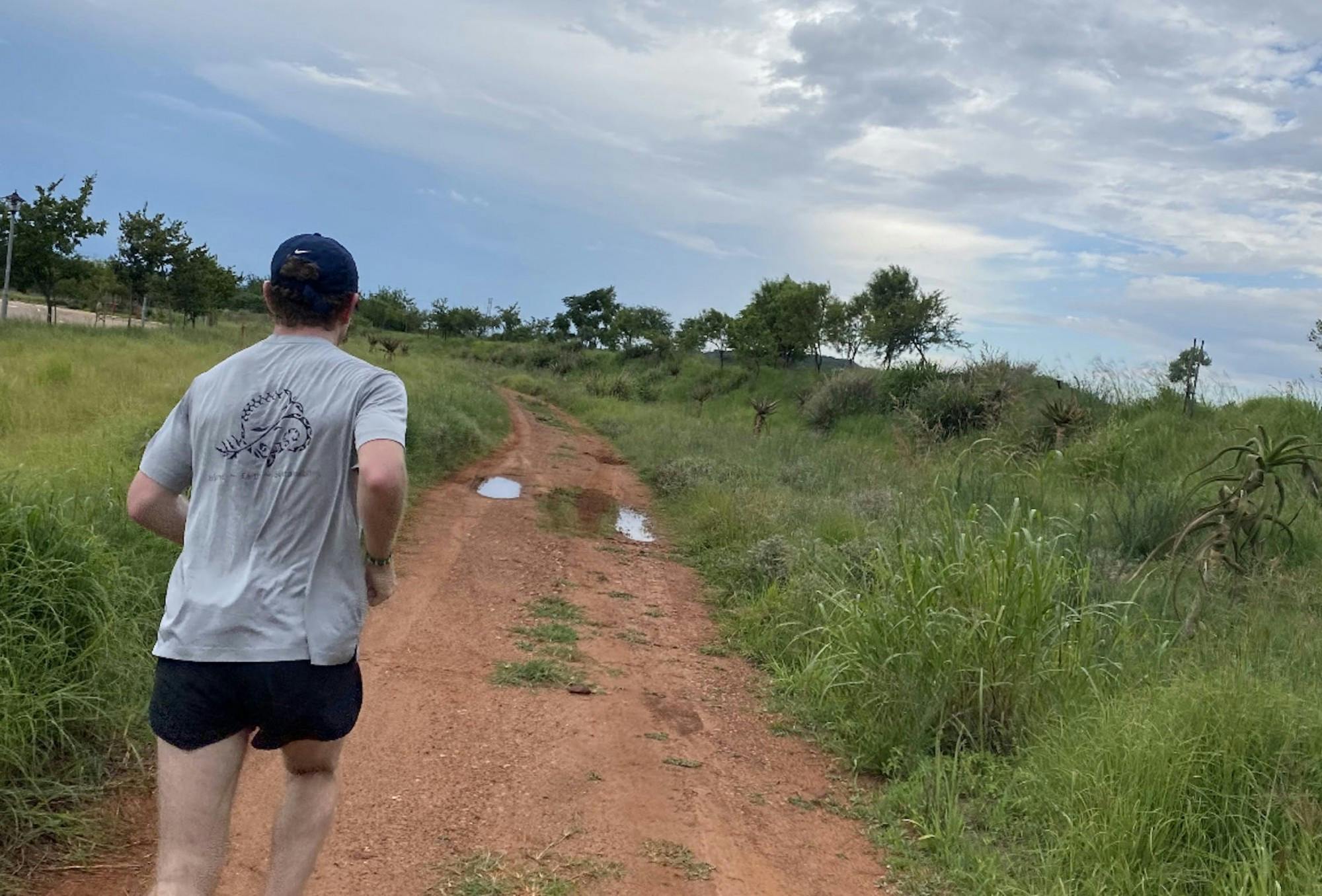This winter break, I had the opportunity to embark on a trip to South Africa with the Rockefeller Center for Public Policy. The purpose of this two week trip was to study racial reconciliation policy post-apartheid, which included daily meetings with experts in the policy, business, education or nonprofit sectors, speaking with locals about their experiences, immersing ourselves in the culture and ultimately producing a memo with policy recommendations.
While this entailed an intense daily schedule, I also had to train for the winter indoor track season. Over this period, my training entailed running lots of base mileage with my teammate Drew Thompson ’22 — another member of the trip. Our runs gave us a new window to observe the country through. The roads we ran on embodied the signs of economic inequality we had read about, and — as white men — to have the privilege to safely go for a run is a first hand example of the privilege enjoyed by white people in South Africa — notably, the only other people we saw running while in Johannesburg were white as well.
We began the trip with a 24-hour travel day from Boston to London, and then from London to Johannesburg, South Africa. From Oliver Tambo International Airport, we headed to our hotel in Sandton City — an area notorious for being the richest square mile in all of Africa (yes, the entire continent) — situated in the country with the highest income inequality in the world.
As we began our first run, the two of us headed towards what Google Maps claimed to be a large park near the freeway, attempting to squeeze side-by-side on the skinny Johannesburg sidewalk — a couple of close calls with speeding mini buses soon prompted us to run single-file. Navigating the intersections was difficult as well, given that energy shortages in the country have led to some non-functioning traffic lights.

At the park, we were relieved to run side-by-side again for about 300 meters until we began to smell something unusual. We came upon a town made up of a cluster of 10 shacks built from scraps, used as homes in the middle of the park and adjacent to a large pile of burning garbage. While we had heard about the dangers of these impoverished areas, we had determined it was a short run through the town and nowhere else to go. In the town, people seemed to be enjoying themselves — a group of younger boys were chatting on a bench and waved to us while kids to our right were playing soccer. However, the poverty of the area was evident along with the blatant inequality of the country — especially compared to the location of our next run.
Drew and I started the next day’s run at 6:30 a.m. and headed towards Hyde Park High School. During the first mile in this direction, we passed a group of people dragging massive carts behind them. These people were scrap collectors — they go into the city at dawn, search for discarded scrap metal or electronics no longer needed by businesses in the massive skyscrapers and then sell them to scrapyards. Yet, severe inequality continued as we entered Hyde Park and the buildings morphed from offices to estates.
Each home stood at least three stories tall, with beautifully intimidating cement walls –– 12 feet tall and four feet thick. Squadrons of private security guards lined these walls, each sporting assault rifles. As we ran, two guards at an estate stepped out into the road with their guns; Drew and I hesitantly slowed our pace. A loud motor engine sounded, and a low-riding Porsche emerged from behind the wall, drove off and the guards retreated. It was ridiculous — this homeowner had an entire staff who simply stood by the car as it exited their estate. These mansions with privatized security sat just miles away from the shack dwellings burning their own trash the day before. As two white men running through a predominantly white and heavily armed neighborhood, we acknowledged our privilege and wondered how we would have been received by the guards had our skin been a different color.
We stuck to running in Hyde Park the next few days until we packed up for our night in Pretoria, one of the country’s three capitals. There, we ran towards the University of Pretoria — a top-ranked university in South Africa — which had four recreational fields as well as track and soccer stadiums. It seemed very similar to an American university as we passed students walking to classes.Unfortunately, we only got to run here twice before we headed to our final destination of Cape Town.

At this point, we were exhausted. Running 70 miles the past week on six hours of sleep with a rigorous day schedule, we prayed for an enjoyable route in Cape Town. Luckily, our hotel was right on the wharf. A mile’s jog on a significantly larger sidewalk, compared to those in Johannesburg, took us to a promenade along the coast.
On our route, we passed a group of teenagers wearing red shorts, Santa hats and red body paint in place of a shirt — it was eerily familiar to a group of Dartmouth students during an on-night. We then encountered one of South Africa’s stadiums that hosted the 2010 FIFA World Cup and became surrounded by people dressed in the same manner. Cape Town was hosting one of the stops in the Rugby World Cup Tournament the same weekend we were there. It inspired hope in us to see the stadium in use, as structures built for international competitions in developing countries frequently become abandoned after the original event.
Once we hit the promenade, it felt like we were running in Santa Monica. Off the coast, Robben Island lay in the distance — where Nelson Mandela was held in prison during Apartheid for 27 years — and back on land stood the iconic Table Mountain. The path was overflowing with runners, bikers and dog walkers. While we had to avoid more people than usual, we were just happy to be dodging people rather than cars. Despite our exhaustion, these runs were quite enjoyable — you can’t ask for much more than a flat route along the coast.

With Cape Town being our last stop, Drew threw out his shoes — they had accumulated a nasty smell throughout the trip quite similar to that of the burning trash from the first day — and we welcomed what turned into a 30-hour travel day back to the U.S.. Long hours of inactivity did wonders for our tired legs, and stretching our calves on the stairs of the double-decker plane coupled with the trusty Theragun at the airport gate kept us from cramping.
As we returned home, we realized that our running allowed us to encounter many examples of what we had read about the country throughout our class. The 142.5 miles we ran in the country granted us a stronger understanding of the plethora of issues the everyday person of South Africa faces — as well as where the small pockets of hope lay. It was an incredible experience that I will certainly hold on to over these next few months while we zip up our running jackets, tie our shoes extra tight and train in this Hanover winter.




